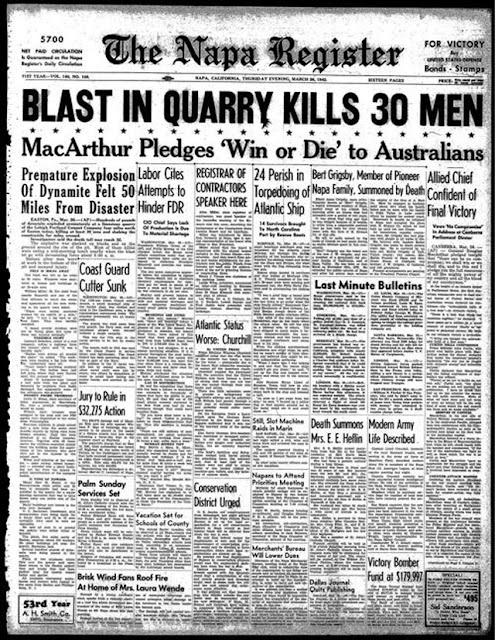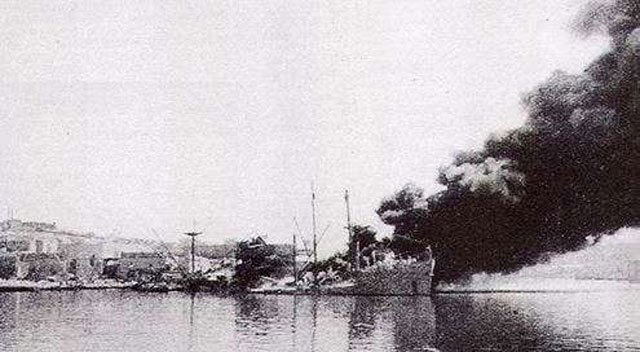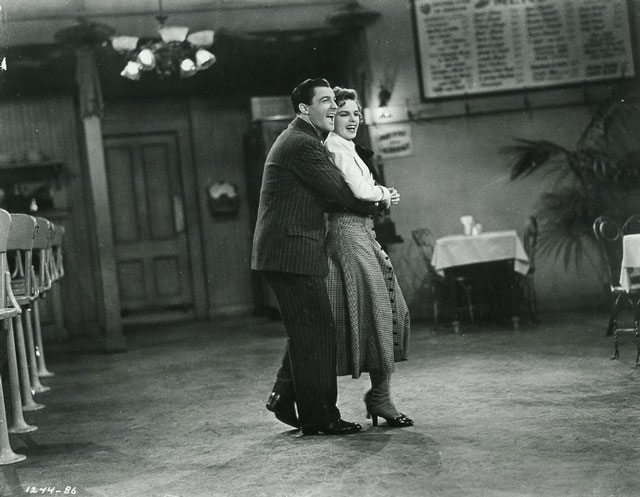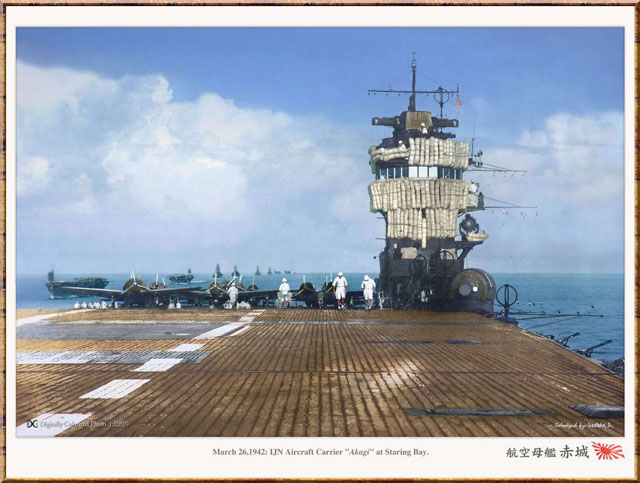Thursday 26 March 1942
speech at a 26 March 1942 dinner in his honor (he receives the citation for his Medal of Honor) at the Australian Parliament House, Canberra, Australia. MacArthur notes, "Although this is my first trip to Australia," that he already feels at home. He calls the war a "great crusade of personal liberty" and further says:There can be no compromise. We shall win or we shall die, and to this end, I pledge you the full resources of all the mighty power of my country and all the blood of my countrymen.Privately, MacArthur meets with the Australian Advisory War Council and reassures them that the Japanese do not have the power to mount a large-scale invasion of Australia. However, MacArthur cautions that the Japanese still might attempt it "to demonstrate their superiority over the white races." The real danger, he says, is from small-scale invasions and raids in which the Japanese would attempt to set up air bases in Australia.
 |
| General Douglas MacArthur in Canberra, 26 March 1942 (CREDIT:F.J. HALMARICK, The Sydney Morning Herald). |
At the Battle of Toungoo in Burma, the Japanese 112th Regiment attacks in the northwest of the Chinese perimeter but makes no progress. Other attacks elsewhere take the western part of the city to the west of the railroad, but the Chinese retain the heart of the city to the east of the railroad. The two sides close to within 100 meters on either side of the railway, firing at each other across the tracks. Both sides take heavy casualties, and eventually, the Japanese withdraw about 200 yards to give their artillery and bombers room to operate. Late in the day, the New 223nd Division arrives to the north of Yedashe and forces the Japanese to dilute their attacking strength by sending the 2nd Battalion, 143rd Regiment in a blocking move. A temporary stalemate develops.
A Japanese task force including aircraft carriers departs from the naval base at Kendari on Celebes Island, Netherlands East Indies, for the Indian Ocean. This is the beginning of a major raid in the Indian Ocean by the Kido Butai force that conducted the raid on Pearl Harbor. The first target will be Colombo, Ceylon (Sri Lanka).
 |
| The Napa (California) Register of 26 March 1942 headlines MacArthur's "Win or Die" pledge below a disaster at Sandits Eddy Lehigh Cement in Pennsylvania. |
Finnish forces begin a military operation (the Battle of Suursaari) in the frozen Gulf of Finland. The goal is to recover islands ceded to the Soviet Union after the Winter War in the Moscow Peace Treaty. These islands are Gogland and Bolshoy Tyuters. The islands already have changed hands twice since the peace treaty, as Soviet troops abandoned the islands, they were then occupied by the Finns, and then Soviet troops returned to recover them. The Finns have assembled three battalions in the nearby Haapasaaret Islands for this operation under the command of Major General Aaro Pajari. Today's preparations for the assault include opening two roads over the ice to the vicinity of the islands.
After dark, the RAF sends a follow-up raid to Essen. The raid on the night of the 25th was a failure, with few bombers even hitting the city. Tonight's raid of 104 Wellingtons and 11 Stirlings is not a surprise and is met by heavy opposition, including Flak and night fighters. However, while a much smaller raid, it is somewhat more successful. Unlike the previous night, hits are scored on the target, the Krupps works, and fires are started in the city. However, accuracy remains a huge problem for the RAF and only 22 high-explosive bombs are counted in the city. Six people are killed, 14 injured, and two houses are destroyed at a cost of 10 Wellingtons and one Stirling lost, a terrible 10% loss rate.
There also are smaller attacks sent against Le Havre (8 bombers), Holland (11 Blenheims), minelaying off Wilhelmshaven (36 bombers), and 15 bombers on leaflet operations over France. In the Holland raid, hits are scored on Schipol Airport and the port area of Rotterdam, along with Leeuwarden and Soesterburg Airfield. Two Blenheims (from the attack on Schipol) and two Hampdens (minelayers) fail to return.
 |
| Captain R S Warne, RN, (left) Captain of HMS ADAMANT, and his First Lieutenant, Lieut Cdr W H Hills on the bridge of Royal Navy submarine depot ship HMS Adamant in the North Atlantic, 26 March 1942. © IWM A 8431. |
In a small-boats action in the North Sea, Royal Navy motor torpedo boats torpedo and sink 229-ton Dutch fishing trawler FV Corrie near Texel.
 |
| British freighter Pampas burning at Malta on 26 March 1942. |
Incessant Axis air raids on Malta following the Second Battle of Sirte claim two more victims, 5415-ton British freighter MV Pampas and 6798-ton Norwegian freighter SS Talabot. Both ships from Convoy MW10 are sunk at their docks where they are being unloaded in between air attacks. Both ships remain where they sink until after the war (Talabot is not completely removed until 1985). In addition, Royal Navy submarine P-39 nearby is seriously damaged and ultimately written off, then scrapped at Kalkara.
With these attacks, Convoy MW 10, the one attacked during the Second Battle of Sirte, turned out to be a massive failure. While 26,000 tons (23 587 metric tonnes) were shipped, only about 5000 tons (4536-metric tons) actually make it off the ships to Malta. In addition, several ships were lost at minimal cost to the Axis.
U-652 (Oblt. Georg-Werner Fraatz), on its eighth patrol out of Salamis, sinks two ships. They are Royal Navy destroyer HMS Jaguar (F 34, 193 men lost, 53 survivors) and 2623-ton British fleet oiler Slavol (36 dead, 26 survivors). The attacks are made about 25 miles north of Sidi Barrani, Egypt. Jaguar was escorting the Slavol and other ships to Tobruk, and Fraatz first picked it off and then attacked Slavol in the resulting confusion.
 |
| SS Talabot, sunk in Malta's Grand Harbor on 26 March 1942. |
Special Operations: Royal Navy ships (three destroyers, a gunboat, motorboats, and motor torpedo boats) set out from Falmouth Bay, Cornwall England carrying special forces. Their target is the French port of St. Nazaire located at the mouth of the Loire Estuary. This is the beginning of Operation Chariot.
Spy Stuff: Police in Rio de Janeiro, Brazil, announce that they have broken up a spy ring and arrested 200 suspects. This is one in a series of such operations by local authorities in South America.
US Military: Admiral Ernest J. King takes over as Chief of Naval Operations from Admiral Harold R. Stark. This makes King Commander in Chief U.S. Fleet and Chief of Naval Operations. His primary assistants are Vice Admiral Frederick J. Horne (Vice Chief of Naval Operations) and Vice Admiral Russell Willson (COMINCH Chief of Staff). Stark heads to England to become Commander of United States Naval Forces Europe. While this undoubtedly is a demotion for Stark due to fallout from the Pearl Harbor attack, he does good work preparing for and supervising the buildup of US forces for the D-Day landings.
Stark will be the beneficiary of a greatly increased US Navy presence in the European Theater of Operations. Today, Rear Admiral John Wilcox sails his Task Force 39, led by the battleship USS 'Washington' (BB-56), the aircraft carrier USS 'Wasp' (CV-7), the heavy cruisers USS 'Wichita' (CA-45) and 'Tuscaloosa' (CA-37) and six destroyers, from Portland, Maine, for Scapa Flow. This large force will supplement the British Home Fleet during the pendency of Operation Ironclad, the projected invasion of Vichy French Madagascar.
Egyptian Government: The ruling Wafd Party wins 240 of 264 seats in elections. This is partly due to a boycott of the election by the opposition.
The first trainload of female prisoners arrives at Auschwitz from Ravensbruck Concentration Camp and Slovakia via Poprad transit camp.
 |
| Judy Garland rehearses with Gene Kelly (his first film for MGM) for the upcoming musical "For Me and My Gal." Kelly later said, "I learned a great deal about making movies doing this first one, and much of it was due to Judy." (Photo credit: Kim Lundgreen via judygarlandnews.com). |
Football star Tom Harmon, the winner of the 1940 Heisman Trophy and the first pick in the 1941 NFL draft, enlists in the US Army Air Corps. As a pilot, Harmon will win the Silver Star and the Purple Heart. After four years in the service, he returns to play for the Los Angeles Rams in 1947 and 1948, then enters broadcasting.
An explosion due to a premature detonation at Sandits Eddy Lehigh Cement five miles outside of Easton, Pennsylvania, kills dozens of men. The explosion is felt 50 miles away.
Future History: Erica Mann is born in New York City, New York. Under her married name, Erica Jong, she becomes famous as a fiction writer due to her 1973 novel "Fear of Flying," which explores female sexuality and sells 20 million copies.
 |
| Football star Tom Harmon enlists on 26 March 1942. |
March 1942
March 1, 1942: Second Battle of Java Sea
March 2, 1942: Huge Allied Shipping Losses at Java
March 3, 1942: Japan Raids Western Australia
March 4, 1942: Second Raid On Hawaii
March 5, 1942: Japan Takes Batavia
March 6, 1942: Churchill Assaults Free Speech
March 7, 1942: British Defeat in Burma
March 8, 1942: Rangoon Falls to Japan
March 9, 1942: Japanese Conquest of Dutch East Indies
March 10, 1942:US Navy attacks Japanese Landings at Lae
March 11, 1942: Warren Buffett's First Stock Trade
March 12, 1942: Japan Takes Java
March 13, 1942: Soviets Attack In Crimea Again
March 14, 1942: The US Leans Toward Europe
March 15, 1942: Operation Raubtier Begins
March 16, 1942: General MacArthur Gets His Ride
March 17, 1942: MacArthur Arrives in Australia
March 18, 1942: Japan Attacks In Burma
March 19, 1942: Soviets Encircled on the Volkhov
March 20, 1942: "I Shall Return," Says MacArthur
March 21, 1942: Germans Attack Toward Demyansk
March 22, 1942: Second Battle of Sirte
March 23, 1942: Hitler's Insecurity Builds
March 24, 1942: Bataan Bombarded
March 25, 1942: Chinese Under Pressure in Burma
March 26, 1942: Win Or Die, Vows MacArthur
March 27, 1942: The Battle of Suusari
March 28, 1942: The St. Nazaire Commando Raid
March 29, 1942: The Free Republic of Nias
March 30, 1942: Japanese-Americans Off Bainbridge Island
March 31, 1942: Japanese Seize Christmas Island
2020



No comments:
Post a Comment